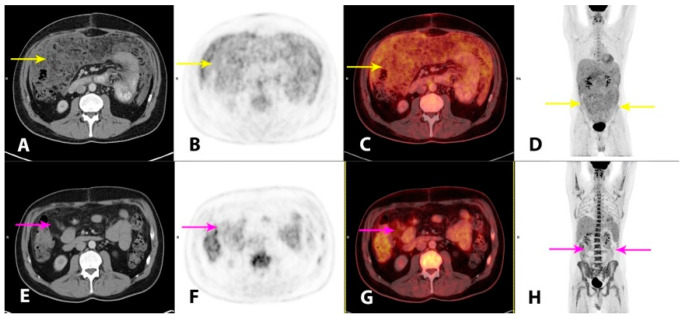Figure 3.
Hybrid imaging with 2-deoxy-2-[18F]fluoro-D-glucose positron emission tomography/CT (2-[18F]FDG PET/CT) was performed for the staging of the disease and as baseline for monitoring of the treatment response. Imaging performed 1 h post-injection of 4.0 MBq/kg 2-[18F]FDG showed a moderately metabolically active, irregular thickening of the peritoneal folds and extensive carcinomatosis-like infiltration in the omentum, mesentery and the pelvic cavity (A–D, yellow arrows). There was minor ascitic fluid in the abdominal and pelvic cavities. There were also metabolically active, enlarged lymph nodes in the mediastinum and upper retroperitoneum. The findings were considered highly suspicious for malignancy. At this point, plasma lactate dehydrogenase (LDH) levels, a future tumor marker in this patient, were elevated (366 U/L; reference range 105–205 U/L). An initial steroid treatment with prednisolone 100 mg/daily had a good effect on the tendency of the recollection of ascites. However, as no standardized treatment for this patient category without comorbidity exists, a hematological specialized tumor board, after consent from the patient, decided to administer a chemotherapy regimen of ifosfamide, carboplatin and etoposide (ICE), which was initiated one month after initial hospitalization. The patient tolerated the treatment well. At clinical follow-up after two cycles of ICE, the patient’s wellbeing was improved, the plasma LDH was normalized and imaging with 2-[18F]FDG PET/CT demonstrated a substantial partial response (PR), both metabolically and morphologically, of the previously described findings in the peritoneum. There were still metabolically active, carcinomatosis-like findings in the omentum, mesentery and on the liver surface (E–H, magenta arrows). There were no pathological lymph nodes. After completion of four cycles of ICE, the metabolic complete response (CR) and a further morphological PR were reported on follow-up 2-[18F]FDG PET/CT (not shown). The plasma LDH was still within a normal range. The patient tolerated the fifth and final cycle of ICE well.

